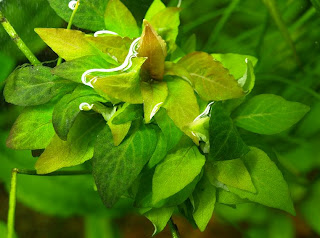Aquatic Plant Hygrophila Corymbosa
 Hygrophila corymbosa is a very hardy, fast growing plant. The genus Hygrophila has been first described by Brown in 1810. In 1826, Blume described this same genus under the name Nomaphila. According to the Aquatic Plant Book by Christopher D.K. Cook - the two names would be synonymous and both names could be used to describe the Hygrophila genus. Lots of cultivated variety of the Hygrophila corymbosa species is commercially available. Hygrophila corymbosa “augustifolia”, “compact”, “aroma”, “siamensis” and “stricta” are all variation of the natural corymbosa species. Hygrophila corymbosa, also known as Hygrophila stricta, originates from Southeast Asia (Thailand, India, and Malaysia). In the US, it is found in certain part of Florida.
Hygrophila corymbosa is a very hardy, fast growing plant. The genus Hygrophila has been first described by Brown in 1810. In 1826, Blume described this same genus under the name Nomaphila. According to the Aquatic Plant Book by Christopher D.K. Cook - the two names would be synonymous and both names could be used to describe the Hygrophila genus. Lots of cultivated variety of the Hygrophila corymbosa species is commercially available. Hygrophila corymbosa “augustifolia”, “compact”, “aroma”, “siamensis” and “stricta” are all variation of the natural corymbosa species. Hygrophila corymbosa, also known as Hygrophila stricta, originates from Southeast Asia (Thailand, India, and Malaysia). In the US, it is found in certain part of Florida.Hygrophila corymbosa has long and narrow pointy leaves with an average of 3 to 5 inches. If let grown, the height of the plant can reach up to 24 inches. The leaves are bright green and quite dense if the plant is kept in proper conditions. Because it is fast growing, this plant can be used as cycling plants. They are also very popular in Dutch aquarium for their bushy appearance and in cichlid tanks for their ability to adapt to a broad range of water parameters.
In the wild, this freshwater aquarium plants can be seen in both its submerged and emersed forms. The roots develop in a wet substrate while the leaves grow above or below the water line. When the leaves reach above the water line, they usually become blue/brown, the stem becomes stronger and little blue flowers start blooming. The size of the leaves will also vary depending if the plant grows emersed or submerged.
 Although Hygrophila corymbosa is very hardy, it will thrive best in a rich substrate. Iron, minerals and strong lighting are recommended for the plant to develop bright green leaves and to get a bushier appearance. One problem encounters by many aquascapers familiar with this plant is that it will loose its lower leaves if the plant in not kept in the best conditions and pruned on a regular basis. This problem reside in the fact that when they grow, the upper leaves create shade for the lower portion of the leaves on the stem, which results in a lack of lighting and disintegration of the leaves. For this reason, it is strongly recommended to prune the plants before they reach the water line, unless the tank benefits of optimum water and lighting conditions. Trimming Hygrophila corymbosa regularly will also increase the diameter of the plant, giving it a bushier appearance. Propagation is done through cuttings.
Although Hygrophila corymbosa is very hardy, it will thrive best in a rich substrate. Iron, minerals and strong lighting are recommended for the plant to develop bright green leaves and to get a bushier appearance. One problem encounters by many aquascapers familiar with this plant is that it will loose its lower leaves if the plant in not kept in the best conditions and pruned on a regular basis. This problem reside in the fact that when they grow, the upper leaves create shade for the lower portion of the leaves on the stem, which results in a lack of lighting and disintegration of the leaves. For this reason, it is strongly recommended to prune the plants before they reach the water line, unless the tank benefits of optimum water and lighting conditions. Trimming Hygrophila corymbosa regularly will also increase the diameter of the plant, giving it a bushier appearance. Propagation is done through cuttings.Hygrophila corymbosa is one of beautiful and hardy aquatic plants species such as Hygrophila polysperma that doesn't require much attention to grow well. It grows pretty large leaves, allowing a single stem to occupy a significant part of the tank. Left alone, it easily crosses the water surface and begins to assume its emersed form: the leaves are darker and harder, and the plant produces purple flowers that give out a pleasant scent. But in this case it also ends up shedding all underwater leaves, so frequent pruning aquarium plants is required if you don't want that. Any pruned stem may be buried in the gravel and will readily generate a new plant. Even without enriched soil, this plant will create strong roots. There seems to be some confusion in literature between the names Hygrophila corymbosa, Hygrophila stricta and Nomaphila stricta. Possibly these are all variants of the same "aquatic plants species".









